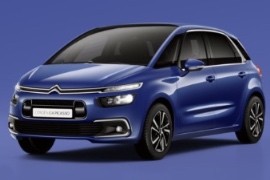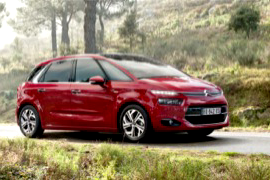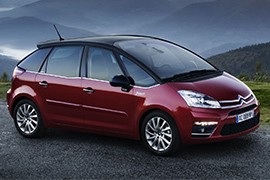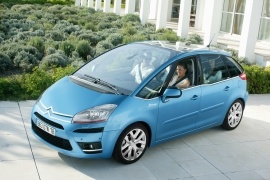CITROEN C4 Picasso Models/Series Timeline, Specifications & Photos
First production year: 2007
Engines: Gasoline, Diesel
Body style: Van
The 2016 Citroen C4 Picasso represents the facelift of the second generation of the C4 Picasso that was launched in 2013.
The model also comes in the Citroen Grand C4 Picasso version, having a lengthened wheelbase and providing more space to have a third row of seats in the back of the car. The Grand variant also has a lot more cargo space as it has a capacity of approximately 700 liters, 150 more than the standard version.
Besides the various gasoline and diesel engine inherited from the pre-facelift model, the 2016 C4 Picasso has a new PureTech 1.2-liter turbocharged three-cylinder gasoline engine that comes packaged with an EAT6 six-speed automatic transmission.
The front of the car is completely redesigned and displays numerous chrome inserts that give the vehicle a modern look, helping also to highlight the key features of the front end. There is also a different approach for the back of the Citroen, with redesigned taillights offering a unique 3D look that further enhances the futuristic aspect of the car.
More customization options are offered through the new color palette for the exterior of the C4 Picasso and through the optional five-spoke 17-inch diamond-finish alloy wheels that come in multiple colors. An optional two-tone black roof can create a contrast to underline the shapes and colors of the body elements.
The interior updates didn't disappoint, as the facelift model has four new designs available, each coming with unique colors, materials, and features. The variants include options like massaging seats, second-row solar blinds, and ambient fragrance dispensers combined with materials like Nappa leather.
To further increase comfort, the Citroen has upgraded suspension to provide more stability and also has an electric power steering system that lowers the vibrations propagated to the interior. The rear axle is acoustically isolated to reduce the noise transmitted toward the passengers.
As a stand-out feature of the model, the panoramic glass roof offers improved visibility for all the passengers and makes the interior of the Citroen C4 Picasso feel way more significant than it is.
The facelift also comes with technologically advanced features, such as a seven-inch touchscreen meant to improve accessibility and provide a canvas for the 3D CITROËN Connect Nav navigation system. As technology isn't limited to the vehicle's interior, the Citroen also adds the Hands-Free Tailgate system that enables the trunk's opening with a movement of the foot in case the hands are unavailable.
The 2016 C4 Picasso represents one of the most updated vehicles from Citroen, making its way through time with its modern look and with the help of all the technology features that increase safety and comfort and offer the passengers a pleasant ride.
Citroen introduced the second generation of the C4 Picasso in 2013, building a minivan on top of the PSA Group’s EMP2 modular platform, trying to convince customers that MPVs were worth it.
While more and more customers started to look for crossovers and MPVs, Citroen kept its idea that MPVs were excellent family haulers. In a way, they were right, but so were the customers who could choose something more suitable for their needs. They understood that most of the time, they didn’t need that ample room and considered that higher ground clearance and a large enough trunk could help them better when shopping, camping, or cross-country trips. That was just one of the reasons why this segment shrunk. In this segment, Renault was the only automaker who managed to get a bigger chunk of the market, while Citroen tried to catch up. Furthermore, several automakers in the segment could provide similar vehicles based on compact-sized or scalable platforms.
The car’s front sported a new design with slim LED daytime running lights placed above the headlights, which were installed in the bumper. Lower, in the apron, customers had the option to equip the C4 Picasso with a set of fog lamps that flanked the broad, hexagonal-shaped grille. For the 2013 model, the C4 Picasso offered customers a vehicle with an impressively large glass area. Apart from the panoramic windshield, the car featured a set of triangular windows between the A-pillars and the front doors, which was somehow unusual. Still, that was a good thing since it improved the driver’s visibility. At the back, the automaker installed an additional set of windows behind the rear doors, which, together with the rear glass area from the tailgate, raised the total number of windows to ten. For a European car, that was a lot.
But those inside the cabin could enjoy the excellent view of the exterior. At the front, Citroen installed higher seats to give occupants better visibility to the outside. The dashboard sported rounded shapes and a center-mounted instrument cluster that could be seen by those seated in the back. Underneath it, on the center stack, the French automaker offered the option for an advanced infotainment system that featured navigation but fitted the base models just with a CD stereo. The driver was separated by their side passengers by a center console that housed the gear stick. The C4 Picasso couldn’t be crossed from side to side at the front. In the back, the automaker placed three individual seats that could recline and slide according to passengers’ desires.
Under the hood, Citroen offered customers a wide choice of turbocharged diesel and gasoline engines. Most versions came fitted as standard with five-speed manual gearboxes, while selected versions were available with a six-speed automatic. The automaker kept the C4 on the market until 2022, when it pulled the plug on it, replacing the MPV with the C5 Aircross crossover SUV.
CITROEN C4 Picasso 1.6L BlueHDI 5MT FWD (100 HP)
CITROEN C4 Picasso 1.6L BlueHDi 6MT FWD (120 HP)
CITROEN C4 Picasso 1.6L e-HDI 6AT FWD (115 HP)
CITROEN C4 Picasso 1.6L e-HDI 6AT FWD (90 HP)
CITROEN C4 Picasso 1.6L e-HDI 6MT FWD (115 HP)
CITROEN C4 Picasso 1.6L HDI 6MT FWD (90 HP)
The European MPV market was not that big anymore by the late 2000s, but the French car-makers still had an advantage on the market due to their history in that segment.
Citroen insisted on offering spacious vehicles with a high level of on-board safety for its customers. The C4 Picasso was a good example of its egg-shaped form and sharp frontal area, typical for Citroen.
From the exterior, there were minor modifications to the car. At the front, a line of LEDs installed on top of the fog-lights formed the daytime running lights, which became mandatory. The front bumper was modified to support the new elements. The chromed lines that formed the brand's logo on the hood were thicker to enhance the car's image.
The interior was good for up to five adults on the regular size or up to seven for the Grand Picasso version (long-wheelbase). With its instrument cluster installed on top of the center stack, the driver could not hide the actual speed from other passengers. A small and thin lever was installed on the steering column's right side for the automated transmission versions. The manual version still hed the floor-mounted gearstick.
The European customers preferred diesel engines over gasoline ones on the MPV market. That's why the C4 Picasso was offered with just two gasoline versions and up to five diesel. A mild-hybrid was introduced and helped increase the in-city fuel-efficiency.
Citroen still believed that there was a good market for MPVs in Europe and introduced a second generation for the compact-segment Picasso lineup in 2007.
While the first generation of the Picasso was based on the Xsara platform, the 2007 model relied on the PF2 base, used for more vehicles within the PSA (Peugeot-Citroen) Group. The carmaker used simple solutions for that, with independent front suspension and trailing arms for the rear ones.
Since the bio-design era was gone, the carmaker stepped into the new-edge-design trend and made the C4 Picasso with angular-shaped headlights. Its broad trapezoidal grille was crossed by a horizontal element that supported the license plate. Several side louvers on the sides of the bumper made the front fascia more pleasant. Citroen introduced on the C4 Picasso its new signature with two wide chromed slats underlining the "double-chevron" badge from the hood. On its sides, the MPV showed its tall stance with wide windows for all passengers but smaller, triangular ones behind the rear doors. At the back, a sloped windscreen ended the vehicle in a Kamm-back style.
Inside, the carmaker installed five individual seats with an option for four. At the front, the vast and deep dashboard took the entire space between the A-pillars and the bottom of the raked windshield. Due to the center-mounted instrument cluster, even the rear passengers could have read the vehicle's speed, which was shown on a large LCD. As an option, the carmaker added a panoramic, fixed glass roof to emphasize the car's airy feeling.
Under the hood, the carmaker installed a wide engine range paired to either manual or automated transmissions.



